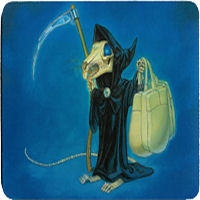
Death of Rats
CBUB Wins: 2
CBUB Losses: 1
CBUB Ties: 0
Win Percentage: 66.67%
Added by: lemming
Read more about Death of Rats at: Wikipedia
Official Site: Terry Pratchett
Death is a fictional character in Terry Pratchett's Discworld series and a parody of several other personifications of death. Like most Grim Reaper, he is a black-robed skeleton usually carrying a scythe. He does not appear to be Death in the universal sense; his jurisdiction, so to speak, appears to be only the Discworld itself.
Death's hollow, peculiar voice is represented in the books by unquoted ; since he is a skeleton, he has no vocal cords to speak with, and therefore the words enter the head with no involvement from the ears. His "voice" is often described using a morbid metaphor, such as two concrete blocks being rubbed together, or the slamming of coffin lids; these descriptions have become less frequent in recent novels. In the first Discworld novel The Colour of Magic, as well as in Eric, all direct written references to Death are proper nouns; thus, for example, "he" is written as "He." This is usually reserved for the Discworld gods and is not featured in any of the other novels.
Death is not invisible; however, most people's brains refuse to acknowledge him for who he is, unless he insists. Under normal circumstances, only those of a magical disposition (e.g. witches and wizards), children, and cats can see him, or allow themselves to see him. Due to his eternal nature, Death can ignore such things as walls or magic spells; he exists through all time, and therefore things lasting merely centuries are not as real as he is. He can only go where people believe in death and can only see people who can die.
Wizards, witches, and significant figures such as kings have the prerogative of being collected by Death himself, rather than one of the lesser entities. Most other souls are collected by another functionary, such as the anthropomorphic personification of Scrofula. However, Death himself must collect some minimum number of souls, worked out by a system called the "nodes," in order to keep the momentum of dying going. His selection of ordinary deaths may be based on the showiness of the death, such as a common thief being incinerated by a dragon. In addition to wizards and kings, he has shown up for numerous ordinary people, at least two dogs, a swan, and an incredibly small sea creature (possibly a tube worm). These events are usually of importance within the story, so Death's appearance may simply be considered a plot device. He has also appeared in situations where characters are in mortal peril; for example, Death has appeared before Rincewind on numerous nearly-fatal occasions. And in Thud! Samuel Vimes has a near-death experience, which means that Death has a "near-Vimes experience", in which he appears before the stricken Vimes sitting in a deckchair reading a mystery novel.
CBUB Match Record:
| Result | Opponent | My Score | Their Score | |
|---|---|---|---|---|
| Win | Rescue Rangers | 46 | to | 39 |
| Win | Rouge the Bat | 66 | to | 37 |
| Loss | Mighty Mouse | 42 | to | 55 |
No Fantasy Draft Records Available
